Sympathetic ganglion
| Sympathetic ganglion | |
|---|---|
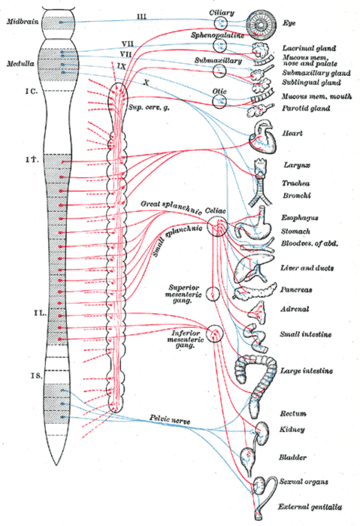 Autonomic nervous system innervation, showing the sympathetic (thoracolumbar) and parasympathetic (craniosacral) systems, in red and blue, respectively | |
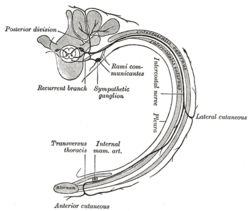 Diagram of the course and branches of a typical intercostal nerve. (Sympathetic ganglion visible at center top.) | |
| Details | |
| Identifiers | |
| Latin | ganglion sympathicum |
| TA | A14.2.00.011 |
| FMA | 5890 |
Sympathetic ganglia are the ganglia of the sympathetic nervous system. They deliver information to the body about stress and impending danger, and are responsible for the familiar fight-or-flight response. They contain approximately 20,000–30,000 nerve cell bodies and are located close to and on either side of the spinal cord in long chains. Sympathetic ganglia are the tissue from which neuroblastoma tumours arise.
Structure
Sympathetic chain ganglia
The bilaterally symmetric sympathetic chain ganglia, also called the paravertebral ganglia, are located just ventral and lateral to the spinal cord. The chain extends from the upper neck down to the coccyx, forming the unpaired coccygeal ganglion. Preganglionic nerves from the spinal cord synapse at one of the chain ganglia, and the postganglionic fiber extends to an effector, a visceral organ in the thoracic cavity, abdominal cavity, or pelvic cavity.
There are usually 22-23 pairs of these ganglia: 3 in the cervical region (cervical ganglia), 11 in the thoracic region (note the presence of the stellate cervicothoracic ganglia), 4 in the lumbar region and 4-5 in the sacral region. Throughout human evolution, the first thoracic and inferior cervical ganglia merged - and this resulting ganglion is called the stellate ganglion (so called because of its radiating pattern similar in appearance to a star).
The general rule of interaction of the nerve fibres in the sympathetic nervous system begins at the spinal cord. Here they arise from the thoracolumbar (T1-L2) regions' lateral horn of grey and emerge via the ventral root. They enter their respective spinal nerve (e.g. T5), and thus enter the white ramus communicans. This myelinated division can then enter the sympathetic chain.
Here four options are available to the fibres: (1) they can run up the chain and synapse, (2) they can synapse at the level of entry, (3) they can pass straight through and synapse elsewhere - such as in the case of T5-12 (the splanchnic nerves), or (4) they can enter the chain and descend to synapse. It is this ability to move superiorly and inferiorly along the chain that results in the mass response to the sympathetic nervous system. A preganglionic fibre may synapse to 15-20 postganglionic fibres.
Upon exiting the sympathetic chain, the fibres enter a less-myelinated gray ramus communicans. There is still a myelin sheath present - just in far lower amounts compared to the white ramus communicans. This ramus then enters the spinal nerve and is sent to its synapsing target, or becomes a visceral branch to enter a plexus (e.g. the superficial or deep cardiac plexuses), or synapses directly onto a target.
Collateral ganglia
Neurons of the collateral ganglia, also called the prevertebral ganglia, receive input from the splanchnic nerves and innervate organs of the abdominal and pelvic region. These include the celiac ganglia, superior mesenteric ganglia, and inferior mesenteric ganglia.
Additional images
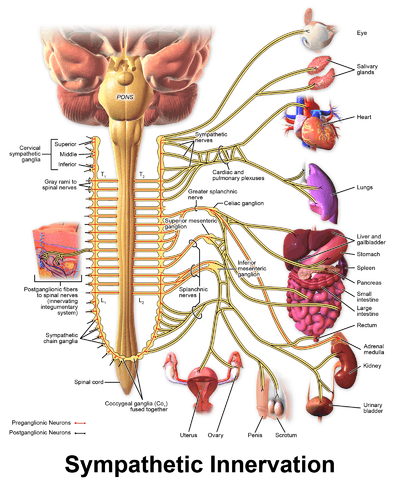 Schematic Illustration of Sympathetic Innervation
Schematic Illustration of Sympathetic Innervation The thoracic aorta, viewed from the left side.
The thoracic aorta, viewed from the left side.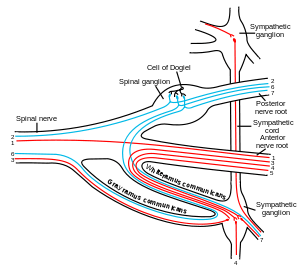 Scheme showing structure of a typical spinal nerve.
Scheme showing structure of a typical spinal nerve.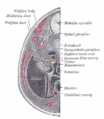 Transverse section of human embryo eight and a half to nine weeks old.
Transverse section of human embryo eight and a half to nine weeks old.
External links
- thoraxlesson5 at The Anatomy Lesson by Wesley Norman (Georgetown University) (paravertebralregion)